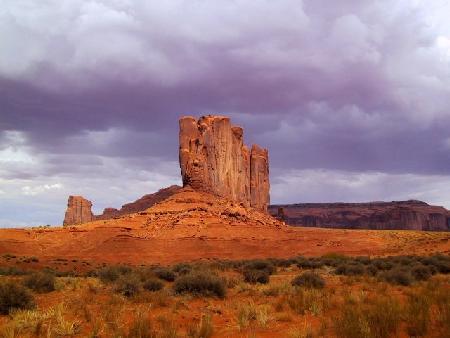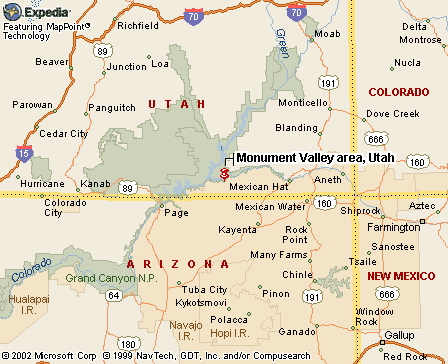|
|
Canku Ota |
|
|
(Many Paths) |
||
|
An Online Newsletter Celebrating Native America |
||
|
June 29, 2002 - Issue 64 |
||
|
|
||
|
Joining Two Worlds |
||
|
by Sararesa Begay The
Navajo Times
|
||
 MONUMENT
VALLEY, Utah - Starlight Benally, a 13-year-old eighth grade student,
pounded the tightly woven maroon-colored churro yarn against the strands
of white yarn with her wooden batting stick as she sat in front of a loom. MONUMENT
VALLEY, Utah - Starlight Benally, a 13-year-old eighth grade student,
pounded the tightly woven maroon-colored churro yarn against the strands
of white yarn with her wooden batting stick as she sat in front of a loom.
Benally, a participant in the Indohoo'aah summer program, is weaving her first rug in a Monument Valley High School classroom. "It's fun," Benally said shyly. "I sold my first sash belt in Oregon." About four years ago, like most young Navajo girls her age, Benally didn't know how to weave a rug or sash belt or spin her own wool. Now Benally knows how to weave a rug, sash belt and a cinch belt, make a Navajo wedding basket, and do beadwork. Benally is part of a three-week summer program called Indahoo'aah, which means "learning and relearning" in the Navajo language. The Indahoo'aah program began in 1994, and was created by Navajo language and culture teacher Don Mose of Monument Valley High School. Technology and tradition "We use culture to learn technology and math," Mose said. "It's putting it together, tradition and technology ... we keep up with technological progress with language and culture in the program." Mose said he wants the Indohoo'aah program to spread across the Navajo reservation so students can have the best of both the Navajo and bilagaana worlds. "Indohoo'aah is like a rug design," Mose said. "We started, we only knew that we were doing something good." Students learn Navajo rug weaving, sash belt weaving, cinch belt weaving, wedding basket making, and beadwork. Additionally, ethobotany, sheep and agricultural components have been added to the program, according to agricultural/science teacher Jack Seltzer. Within the traditional crafts of weaving, beading and basket making are hidden mathematical ideas, according to Mose and Eli Spanier, a former program site supervisor who now works at a foundation at the University of Colorado-Boulder. The program presented a rediscovery of those mathematics ideas and gave real application to the students by using computers to create their ideas, and to use mathematics in their individual craft project. Skilled Navajo elders instruct the student on each area of crafts, Mose said, adding that there are currently nine Navajo elders teaching the students. Students learn Navajo traditional craft making from the elders, and also learn math concepts at the same time. "Now, and often without realizing it, these students are using these math concepts to create beautiful designs," Mose said. Patterns on computer "It's very abstract," said Victoria Williams, an Indohoo'aah program computer teacher. The students are able to describe geometric patterns and relationships when using the computer to design their rug and beadwork patterns, according to Williams. Students are also able to use correct mathematical terminology to discuss shapes and math concepts, and use correct math functions to solve a program and get a correct answer, Williams said. Some of the program goals are to enable students to apply what they have learned and begin to explore on their own. They should begin to compare and self-assess their progress from the beginning of the program to completion of the program. They should also begin to explore foreign mathematical concepts and develop an appreciation of real-life mathematical situations. The students should accurately draw and replicate their crafts using the computer program and make predictions regarding the outcome of their computer-generated image and should continue to recognize geometric concepts outside the classroom. "I learned to measure while rug weaving and I used multiplication, addition and subtraction," Christine Goodman, a program graduate said. "My aunt knew how to weave rugs, but I didn't know about rug weaving before the Indoahoo'aah Program. This math helped me in both rug weaving and beadwork." One Navajo elder who has been instructing beadwork for eight years said the students' abilities vary. "Some of them catch on ... they think good," said Navajo elder Bonnie Atene, 62, of Oljato, Utah. "And then, some of them have a hard time putting their minds into it." Then Atene points to a fidgeting, talkative little boy, Franco Nakai, 8, who is working on his beadwork project across from her desk. Nakai who is from "VCA," which is between Monument Valley, Utah and Mexican Hat, clumsily works on a beadwork project he started four days ago. "(I'm) beading an Indian," Nakaii said as he suddenly gets quiet and serious. Relearning Diné language Mose said he wanted to get beyond students just reading and writing the language, but to actually speak it on an impromptu basis or conversationally. "My vision is to have a Navajo speech class," Mose said, noting that his last Navajo language class was a mixed group of language speakers. "The kids are losing their Navajo." Students in Mose's language class are curriculum developers. Students compose a Navajo language booklet of their own on the computers. The students write the language and present the booklet to grammar school-age students at Navajo Mountain school and Mexican Hat school. The pronunciation of the Navajo language can also be reinforced and reaffirmed by using the computer with a recorded voice program that was demonstrated by Larry Rock, the school's library media specialist. "While other educators develop the tools, here the students develop their own learning tools," Mose said, highlighting that the Navajo elders who instruct the students mostly talk Navajo to the students, too. That's another way to learn the language, Mose said. The sheep component Selzter said about five years ago, the students began to raise their own churro sheep for the wool, which they carded and spun for their rug and belt projects. Now the students shear the churro sheep and process their own wool, Mose said. The students and Selzter have been reintroducing churro sheep to the reservation by starting herds at Blue Gap, Tohatchi, Oljato, Kayenta, Ganado and Pinon, Seltzer said. Last year, the cinch belt-weaving project was introduced after Selzter brought up the idea. Navajo elder Sandra Black, 64, of Promise Rock, Utah, remembered watching her relatives weave the cinch belt during her childhood. Eventually, Black relearned the craft through memory and now instructs students how to weave the cinch belt, which is used for horses, Mose said. Selzter, a non-Indian who has lived on the Navajo reservation for 19 years, also instructs the students in agriculture and ethnobotany, which is the study of how a group of people uses plants and herbs. "Originally, the project of ethnobotany started with pictures and drawings," Seltzer said. "But now it's evolved into a project with 30 to 40 plants, the plants' scientific identification and the plants' Navajo identification and usage." Seltzer said eventually the ethobotany class will create their own CD-ROM with all of their work and research and will develop a Navajo dye and plant component. Students graduate from the program during early July. This year's group will graduate on July 3 with a program certificate and each student's completed craft project. Siberia and the Yukon "(The Kantays) are so amazed at the weaving and the basketmaking," Mose said, noting that the Kantays are similar to the Navajos physically with some cultural similarities. "A lot of what we were doing probably hit home (with them)." Mose said San Juan School District also sent 10 Navajo students to the Yukon. The people of the Yukon sent 10 students to San Juan School District. Currently, there is no research or conclusive data available at this time, Williams said, adding that University of Alaska professor Claudette Bradley who helped create the program has been in poor health, and is unable to conduct research on the program. Funding for this year's program comes from the San Juan School District; Title XII; "Gear Up," an organization for youth programs; Utah Arts Council; the Dudley Family; and the University of Utah Mathematics Department. For more information on the Indohoo'aah program call Mose at 435-678-1208 or send e-mail to: mose_done@mvh.sanjuan.k12.ut.us.
|
|
|
||
|
|
||
| Canku Ota is a free Newsletter celebrating Native America, its traditions and accomplishments . We do not provide subscriber or visitor names to anyone. Some articles presented in Canku Ota may contain copyright material. We have received appropriate permissions for republishing any articles. Material appearing here is distributed without profit or monetary gain to those who have expressed an interest. This is in accordance with Title 17 U.S.C. section 107. | ||
|
Canku Ota is a copyright © 2000, 2001, 2002 of Vicki Lockard and Paul Barry. |
||
 |
 |
|
|
The "Canku Ota - A Newsletter Celebrating Native America" web site and its design is the |
||
|
Copyright © 1999, 2000, 2001, 2002 of Paul C. Barry. |
||
|
All Rights Reserved. |
||
